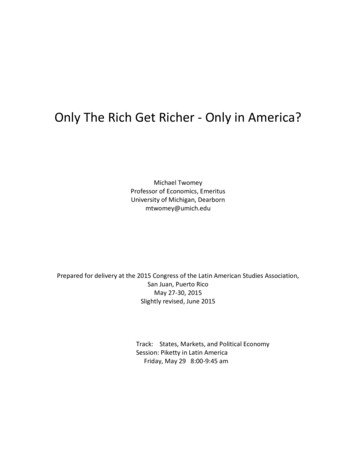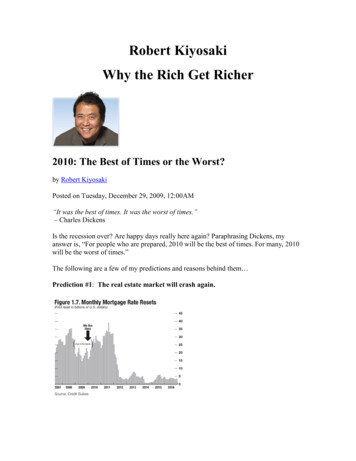
Transcription
Only The Rich Get Richer - Only in America?Michael TwomeyProfessor of Economics, EmeritusUniversity of Michigan, Dearbornmtwomey@umich.eduPrepared for delivery at the 2015 Congress of the Latin American Studies Association,San Juan, Puerto RicoMay 27-30, 2015Slightly revised, June 2015Track: States, Markets, and Political EconomySession: Piketty in Latin AmericaFriday, May 29 8:00-9:45 am
Only The Rich Get Richer - Only in America?Michael TwomeyProfessor of Economics, EmeritusUniversity of Michigan, DearbornJune 2, 2015In 2014, Thomas Piketty’s book Capital in the Twenty-First Century surged to the top ofbest seller lists in the United States, the U.K., Canada, and in France, at least. Harvard’s LarrySummers (2014) called it “Nobel-Prize worthy,” while Branko Milanovik (2014), one of the WorldBank’s leading researchers on income distribution, labeled it a “watershed book.”This paper will address the contributions of the recent surge in published work byThomas Piketty and his co-workers, measuring and analyzing the share of national incomesearned by the richest sectors of the populations, across a variety of countries. This work will bepresented at a LASA session entitled “Piketty in Latin America;” its charge is to describe the workon the US of Piketty et al., leaving to the other panelists the task of extending and commentingon these findings from the perspective of various countries in the region. We begin with anoverview of the methodology employed by Piketty and his co-workers, relating it to other, morefamiliar approaches. One extension of their research is to distinguish the analysis of incomedistribution before and after consideration of government policies such as taxes and subsidies.Following that, there is a section summarizing these findings for the United States and otherhigh income OECD countries. There is an abbreviated set of comments on the extensiveliterature on income distribution in Latin America, and the paper ends with some speculationsabout what future work on this topic for that region might produce. 1The Researchers:Thomsas Piketty is a native of France, and currently an economics professor In Paris. Hisprevious work on income distribution led to a book published in 2001 on the experience ofFrance over the entire 20th century. The book of direct importance to us was originally publishedin French in 2013, with the English translation 2 appearing in 2014. In point of fact, much of themain argument of that book was presented in an article published in 2003, co-authored withEmmanuel Saez. In his recorded interviews available on the web, Piketty points to the importantcontributions of a few close collaborators beyond Saez, such as Anthony Atkinson and FacundoAlvaredo, as well as more than two dozen other researchers who have co-published with thempapers about individual countries. Key publications presenting findings of this group are twocollections of country-specific papers, edited by Atkinson and Piketty, respectively published in2007 and 2010. Their academic contributions have been institutionalized by the establishmentof a web-site which makes all this data on these countries freely accessible to anyone on theinternet, entitled the “World Top Incomes Database”, to be referenced herein as WTID.Quick Sketch of Their Findings1For considerations of space, several graphs and tables are omitted from the paper’s electronic version,which is to be posted on the LASA web-page. The complete paper- including those items in an Appendix is available for download at http://www-personal.umd.umich.edu/ mtwomey/LASA Paper.pdf .2It is customary to use some descriptor such as ‘excellent’ to describe the English translation; credit goesto Arthur Goldhammer, who has done much work for Harvard University and other presses, includingrecent translations of Camus, de Tocqueville, and Zola.
2The work of Piketty, Atkinson, Saez, and their collaborators, focusing on the shares oftop income earners in some twenty countries, makes several noteworthy contributions. The firstis an extended chronological coverage of distribution, backwards in time, as the data on topincomes can be stretched back to the beginning of the twentieth century, which is not possiblefor studies based on household surveys. Secondly, there is an enormous increase in the numberof countries who have been studied using what is essentially the same methodology. In addition,these authors have increased our body of knowledge about the distribution of wealth. Finallythey analyze the distributional impact of taxes, especially, but not only, income and wealthtaxes. In particular, Piketty (2014) recommends a universal wealth tax.The brief summary of their contribution is that it focuses attention on the fraction oftotal income that is earned by small fractions (e. g. 1%, 0.1%) of the highest income people in acountry, perhaps tracing that earnings pattern over time. They have shown that these highincome groups earn much more than was previously appreciated, and that in several countriesduring the last couple of decades, the earnings of the top-income groups have grown muchfaster than those of the rest of the population. The impact of the work of Piketty et al. on thetop one percent was increased because of its influence on political movements in the U.S. andelsewhere that were critical of that small section of the population 3. In the United States, thePiketty/Saez results can be considered a forerunner of the Occupy Wall Street movement, andeffectively helped justify political slogans referring to the “other 99%.” A natural follow-upquestion – the title of this paper - is to ask if this research program applied to Latin Americawould also reveal surprising degrees of concentration of the growth of income in the region. Thelast third of this paper attempts to offer some insights on this issue.In terms of standard economic categories, these studies of income distribution combineand make contributions to economic history, public finance, and macroeconomics. To be fair, itshould be acknowledged that this work often seems to assume that a more equalitariandistribution is to be preferred, with specifying if the reason is economic, political or moral.Several readers have criticized them as ignoring basic microeconomic insights about the positiveinfluence of the profit motive.Significant factors in the buzz surrounding Piketty’s work are his analysis of theconcentration of the holding of wealth, greater importance of inheritance in the formation ofpersonal wealth, and his proposal of an international wealth tax. Wealth is a major focus inPiketty (2014), and in some of the papers in Atkinson and Piketty (2007), but none of thesepapers discusses the distribution of wealth (or capital, in Piketty’s usage) for a third worldcountry, Latin America or elsewhere. Thus, this paper will emphasize the issue of incomedistribution, giving far less focus on wealth.Data SourcesAttention is drawn to the fact that there are numerous sources of data about incomedistribution and Gini coefficients. Two decades ago, economists at the World Bank presented anextensive collection as Deininger and Squire (1996), which reflected their considered judgmentas to the best series available for many countries. The Luxembourg Income Study3A book length summary, written by an informed journalist, is Noah (2012)
3(http://www.lisdatacenter.org/) has been a major source of data and studies. The ECLAC officein Santiago, Chile has been at the forefront of this area of research for several decades. Anothersource is UNU-WIDER (http://www.wider.unu.edu/research/WIID-3a/en GB/wiid/) whichpresents Ginis and breakdowns for many countries around the world. A third option,specializing on data from Latin America is SEDLAC, a joint effort of the World Bank and theUniversidad Nacional de la Plata (http://sedlac.econo.unlp.edu.ar/eng/ ). We will cite belowwork from another cross-national source, the CEQ of Tulane University.Methodological issues: Definition of Income, and Unit of AnalysisBy way of introduction, note that there are several options about what definition ofincome is to be utilized. Some researchers focus directly on consumption, which is easier tomeasure than total earnings. A fuller income concept may attempt to include imputed rent onhousing, interest payments and certain financial returns, such as capital gains. Income fromretirement programs – both private and social security – is difficult to handle; many retireesmaintain a middle class lifestyle with zero incomes, should those payments be included? Themore general version of that issue is the inclusion or not of the impacts of government taxesand subsidies, which in this paper will be called pre-fisc and post-fisc. Furthermore, given thatcertain payments for capital might not be reported by their recipients, in housing surveys orelsewhere, there is the assumption that these sources understate the highest incomes. This haslong been recognized as a weakness in household surveys.Mention should be made that the selection of the unit of analysis must choose betweenindividuals, households or families; in the latter two cases some research converts thefamily/household data to per capita terms. The same data yields different measures ofdistribution, depending on the selected unit of analysis, so care must be taken in comparisons.There is also an established interest in incorporating gender, race, and age into the analysis.Methodological Isssue: Pre-fisc versus Post-fisc DistributionOne consideration being highlighted in discussions of the Piketty literature is whether toinclude the effect on the selected measure of distribution, of governmental spending and taxes– fiscal policy. This paper will utilize the terms pre-fisc and post-fisc to refer, respectively, toincome before and after taking account of fiscal policy. The labels belie the complexity of theissue, both theoretically and politically. The Piketty et al. data refer to pre-fisc income. It will beargued here that redistribution is much more significant in OECD countries than in LatinAmerica.Methodological Issues: Measures of distributionThere are several related indicators studied in the analysis of distribution; povertylevels, the distribution of income, of consumption, or the distribution of wealth 4. Related issues4A terminological clarification may be appropriate. ‘Income’ is what one earns in a given period of time,while ‘wealth’ is the accumulation of all one’s previous savings. The technical terms are that income is aflow, and wealth is a stock. To describe someone as ‘rich’ or ‘wealthy’ should be a reference to the stockof their accumulated savings, but very frequently people use these terms to indicate a high level ofincome. An alternative procedure – more precise but less fluid – would be to refer to individuals as ‘TopIncome’ or ‘High Income’ earners.
4such as poverty and malnutrition are very important, but are not covered in the Piketty et al.work.For most countries, the main sources of raw data for these studies are national surveys(of population such as censuses, or household surveys of income or expenditures). A secondarysource is income tax records, which in the United States are the responsibility of the InternalRevenue Service (IRS). For either source, there is a concern about understatement of income bythe upper level groups. One related source of obfuscation is the common practice ofgovernment agencies not to report income data above a certain level, a practice referred to asTop-coding. An attraction of income tax records is the belief that such under-reporting will beless. An intriguing innovation of investigators in this new approach is to estimate the totalincome of these groups that are under-reported, using an interpolation assuming a Paretodistribution of income. 5One disadvantage of tax records is that low income people often do not need to submitincome tax statements, depending on the institutional setting of a country. Many of the debatesabout income distribution hinge on proposed adjustments for data that does not exist or is weakand/or believed to be incorrect. The reader will recognize that there are many more householdsurveys done, and these have been the main pillars of empirical research.A country’s income distribution can be summarized by indexes, of which the mostfamiliar is the Gini index of concentration; other frequently used measures are those introducedby, and carrying the names of, Pareto, Theil, and Atkinson. A major innovation of Piketty et al. isthat they almost exclusively analyze data in terms of the shares of national income received bythat country’s richest people. 6 This focus on the income shares of the Top Sectors inevitablycomes with a corresponding de-emphasis on the overall distribution of income, as oftenrepresented by the Gini coefficient, but the two measures are usually consistent.Consider the graph below left, illustrating what is called a Lorenz curve, where thehorizontal axis is cumulative percent of the population, and the vertical axis is the fraction of thecountry’s income that is earned by that cumulative fraction of the people. The Gini index is theratio of the area A to the area (A B); its value varies between zero and one (or 100, ifmeasured as a percentage), with higher numbers indicating greater inequality. Correspondingly,the ‘Top Share’ of the Zth percentile is the vertical distance from the top axis down to the curve,corresponding to the wealthiest fraction Z of the population being considered. Once again, itsvalues are bracketed by zero and one (or 100), and higher numbers reflect greater inequality.Naturally, the larger is the fraction Z, the larger its share in national income. We illustrate bothmeasures using the same graph, to emphasize the point that – in principle – both measures canbe generated from the same data, and that upward or downward shifts of the Lorenz curve willaffect both measures in the same direction. Thus, the Gini coefficient and the Top Incomesseries seem to give parallel rankings of inequality. In fact, Leigh (2007) demonstrated significantcorrelations between national Gini coefficients and the shares of either the top ten percent, or5See (Atkinson, 2007); a forerunner of the Piketty Saez analysis was Feenberg and Poterba (1993).It is curious that in his sole-authored books, both around 800 pages in length, Piketty hardly mentionsthe Gini coefficient, while constantly referring to the distribution of income, as indicated by Top Incomeshares. In a review that is generally quite positive, Lindert (2014) calls for a return to the study of incomeshares of the entire population.6
5the top one percent. In the words of that author, “ within-country changes in top incomeshares can be a useful proxy for changes in other inequality measures.” (Leigh, 2007, p. F628).Note that data on the top income share cannot inform much about the distribution of incomefor the rest of the population, in contrast to the Gini coefficient, which at least incorporates datafor the entire country.Graph 1. Lorenz curves, Gini Coefficients, and Top Income Shares.Z%Inc%IncAAAPercent of Population, from poorest to richestIPercent of Population, from poorest to richestThe graph on the right hand side illustrates the familiar point that two differentdistributions may generate the same value of the Gini index, making comparisons tricky whenthe Lorenz curves intersect, because different sectors of the population are benefited or hurt.Comparing two situations where the curves do not intersect, either the Gini coefficient or aspecific top share will give the same ordering of inequality of the two income distributions.Elaboration of the Major Findings of Piketty et al.To introduce our presentation of the data of Piketty and colleagues relating to incomedistribution, Table 1 presents data on Top Income Shares and Gini coefficients for manycountries in the WTID, and their (pre-fisc) Gini coefficients from the OECD. Note that the UnitedStates has one of the highest levels of inequality among the OECD countries, in terms of eithertop income shares, or the Gini coefficient. There is much less information for Latin America inthese two sources, but judging from the top shares, Chile and Colombia have greater inequalitythan the United States, and the Latin American countries have more inequality than the fewAsian countries included.The Table also supports the idea that Gini coefficients and Top Shares provide similarmessages on income distribution. We can see this directly in Graph 2, which uses published
6Table 1. Top Income Shares and Gini Coefficients, OECD Countries, 2008 Top Incomes\Comp20082008Top 10% Top 8.510.59.79.7OECDGini sN. ZealandNorwayPortugalSingaporeSouth AfricaSpainSwedenSwitzerlandU. KingdomUSAUruguay2008Top 10% Top 1%OECDGini A15.217.98.67.111.015.417.913.8Sources: WTID, and OECD.statItalics indicate that the year was not 2008. There was a one year difference in OECD data for Japan,Chile, Switzerland, and Korea. The Gini indexes are ‘pre-fisc’ that is, before considering thedistributional effects of government spending and tax programs. For Mexico and Turkey, therewere no pre-fisc Ginis in the OECD file.Reference years from the WTID were: Portugal, 2005; India, 1998; Germany, 1998; China, 2003;Argentina 2004; Indonesia 2004graphs for the United States and Sweden 7 covering the second half of the twentieth century,which are reproduced below. In these graphs, the selected level of the top share is that of thetop 1%, but in principle, a similar correlation would be seen with a graph of the Gini 8 and theshare of the top 10%, or 0.1%. Note that in both graphs there are separate vertical axes forthese two variables.7The pattern for Sweden is repeated over 1983 to 2010 by either pre-fisc or post-fisc Gini, as shown inthe OECD data, which is repeated in Fritzell et al. (2010). The UNU-WIDER data for the Gini of personalincome since 1950 supports the conclusion of a decline in the pre-fisc Gini from 1951 to 1975, as doesthe Statistics Sweden Report on Income Distribution 2008, graph page 8 for post-fisc Gini coefficientspost 1975. Nevertheless, the Gini data for Sweden in Waldenström’s graph are rather in the middle ofthe series provided for pre-fisc and post-fisc, by the OECD.8Note also that the data series on the US Gini presented by Atkinson results from a merger of two series,first for families, then for households. He also notes the existence of several modifications of themethodology used for the latter series. One presumes the same could be said for the IRS data that Pikettyand Saez use. For neither source do there exist direct estimates of the Ginis without and then with theextra data on high incomes that has been generated by the Piketty and his collaborators, with theexceptions of the rough approximation discussed below.
7Merging various available estimates of the Gini income series revisits the earlytwentieth century situation Kuznets originally described – a post 1929 fall in the concentrationof income, which initially led him to speak of an ‘inverted U’ of concentration. The severalmeasures of concentration for the US reached their lowest levels in the late 1960s, and mosthave recovered to their levels of almost a century ago. This leads Piketty to refer to a U-shapedpattern for the US and other countries, referring to the post WWII era until the present.Graph 2. Gini Coefficients and Top Shares: U.S. and SwedenU.S.: Share of Top 1% and Gini Coefficient,Sweden: Share of Top 1% and Gini1947-2002Coefficient, 1951-2002Source: Atkinson (2007, 20)Source: Waldenström (2009, 10)The Long Term Trend of Top Income Shares during the Twentieth CenturyOne of the fundamental contributions of the Top Incomes project has been to lengthenthe coverage of the time span. Piketty’s reaching back to the pre-World War I era certainlyprovides major insights, such as the finding that there was a widespread decline in Top Income’sshare before 1950. Their explanation for this was that it was due to a reduction in payments tocapital, associated with the 1930s Depression 9, and World War II. Of closer concern to today’sissues, is fact of different experiences across countries of Top Shares in the latter part of thecentury. These are depicted in Graph 3. With just a touch of artistic license, Piketty describesthe left graph as a U, and the right graph as an L. The series for the Anglo-Saxon countries risesignificantly after about 1980, while those for Europe do not. With the exception of China, this isbasically also the case with the other countries covered in Atkinson and Piketty (2010), at leastwhere the comparison is possible.As a noteworthy example of American exceptionalism, the story is spiced up by the factthat the largest increase in gains for the top 1% occurs in the United States. As the graph shows,by 2010 the one percent’s share of US income reached levels higher than those of a centuryearlier. Piketty and Saez (2013, 458) refer to “[T]he most spectacular result coming from theWTID, namely, the very pronounced U-shaped evolution of top income shares in the United9But “The reason why the Great Depression was followed by huge inequality decline is not thedepression, but rather the large political shocks and policy responses – in particular the tremendouschanges in institutions and tax policies – which took place in the 1930s-1940s.” Piketty and Saez (2013,461).
8States over the past century.” 10 For the current period, Piketty speaks of a second Belle Époque,Graph 3. Contrasting Distributional Experiences: the share of income of the top one percent inAnglo-Saxon Countries versus Continental Europe and Japan, 1910-2010GermanyU.S.AU.K.JapanFranceSwedenSource: Piketty (2014, 316)Source: Piketty (2014, 317)while Krugman titled his review of Piketty’s book, “Why We’re in a New Gilded Age,” (Krugman,2014).Analyzing Top Income Data in the United StatesIt is reassuring that the Piketty and Saez estimates of the shares of Top Income groupscorrespond closely with what we might label official US data for those same shares, provided bythe Congressional Budget Office, or CBO. As discussed elsewhere in this paper, the CBO – inrecognition of the problem of understatements of income by respondents in the US tohousehold surveys such as the CPS – began generating fuller estimates of incomes and incomeshares during the late 1980s, by combining CPS data with information from tax statementssubmitted to the Internal Revenue Service (IRS), along methodological lines similar to whatPiketty and his colleagues would later implement.One aspect of the Piketty/Saez findings for the US can be seen in Graph 4. Three TopIncome Groups are included, illustrating the fact that the graphs for closely defined groupsshould be highly correlated, and can be seen as vertical displacements of each other. 1110The newness of this result should not be exaggerated. Lindert (1998, 82) presents for the U.S. anequivalent graph for the share of the Top 5% in the U.S. from 1929 into the 1990s. Galbraith (2014, 79)states that his published research (with Thomas Ferguson), using U.S. payroll records, showed essentiallythe same finding. Indeed, the Gini coefficient for the U.S. (reported in the Carter et al. (2006) HistoricalStatistics of the United States Millennial Edition Table Be23) falls from 0.49 in 1929 to 0.40 in 1962, whilethe Census Bureau’s reported Gini coefficient for families (measure F4, rical/inequality/ ) falls from 0.362 in 1962 to 0.348in 1968, subsequently rising to 0.448 in 2013, which is very close to the path indicated for several ofPiketty’s Top Income Shares. As noted above in the text, the Top Income Shares vary more than the Ginis,but the paths are often quite similar. See also the graphs of Atkinson and Waldenström presented below.11Atkinson et al. (2011, 32) state, “[T]he top percentile plays a major role in the increase in the Gini overthe last three decades and CPS data which do not measure top incomes fail to capture about half of thisincrease in overall inequality.”
9Graph 4. Top Shares of US Income, ThreeGroupsWe can examine thisdata more closely by focusing50on the changes after 1980. InTop 10%40Graph 5, the share of the top30Top1%200.1% did not increase as10Top 0.1%much as that of the entire0top 1%. Secondly, taking1910 1930 1950 1970 1990 2010advantage of Piketty’s longSource: Piketty.pse.ens.fr/capital21ctime-span, we can also see inData refer to income excluding capital gains.thththat Graph that the increase in the share of the 90 to 99 percentile had already started by1950, and had increased rather steadily – if slowly - since then. Indeed, the large U pattern ofthe US income distribution in that graph merely repeats the right half of Piketty’s graph, alsoincluded above in Graph 3. 12Graph 5. Top Shares in the US, Relative to their 1980 Levels: Piketty Data2015Top 10% incomeshare10Top 10%-1% incomeshare5Top 1% income share0Top 1%-0.1% Share-51950197019902010Top 0.1% incomeshareSource: Author’s calculations based on data in the WTIDTo compensate for the fact that the Piketty’s work does not measure the shares ofdifferent groups in bottom four fifths of the population, we will briefly examine income sharedata presented by the CBO for the entire population, both pre-fisc and post-fisc. It isencouraging that the Piketty/Saez figures for the Top Shares are closely paralleled by the‘official’ data of the CBO. In particular, Graph 6 further confirms the Piketty/Saez finding that theincrease in the share of pre-fisc income was not generalized over the entire top twenty percent,but was narrowly limited to those in the top one percent. The CBO data also report that eventhe share of income received by the 80th to 89th percentile gradually fell over those threedecades, while that of the 90th to 99th percentile only increased by less than two percent duringthat entire period. Thus the growth of the share of the top one percent was sufficiently strongto pull up the entire first ten and even twenty percent.Graph 6. Changes in Household Income, Relative to 1980 Levels, US – All Groups(CBO Data)12Piketty’s data reveals this increase in the share of the top one percent with or without the inclusion ofcapital gains.
10121086420-2-4Lowest QuintileSecond QuintileMiddle QuintileFourth QuintileHighest Quintile80th to 89th PercentileTop Ten Percent90th to 99th Percentiles1979198919992009Top 1 PercentSource: Author’s calculations using the statistical appendix to Congressional BudgetOffice (2013) “Trends in the Distribution of Household Income Between 1979 and2007.”Note: Data refer to CBO’s category ‘Before-Tax Income,’ which includes RealizedCapital Gains and Social Security payments. , The US data in the WTID includes SocialSecurity, and is reported for series with or without Realized Capital Gains.More importantly, this graph illustrates that the increases in the shares of the topquintile or top decile occurred at the cost of a decrease in the shares of each of the bottom fourquintiles of the population. One can consider this finding, suggested in Piketty and Saez (2003)and demonstrated in CBO (2013), as an affirmation that in the US during this time, “a rising tidedid not raise all boats.” 13The author of this paper has not found an estimate of how much the incorporation ofnew observations of high income cases will in fact increase the overall Gini coefficient. Atkinson(2007, 19) uses, and Alvaredo (2011) formally derives, a formula for a short-cut estimation ofthis issue, suggesting that the increase will be less than five points. 14 Concrete data for the USare presented in Appendix Table 1, reporting the Ginis of the CBO and CPR, while alsocomparing Top Income Shares of those two sources with WTID. 15 The comparisons are not13Our efforts at offering loose, user-friendly, journalistic phrases should not be allowed to pass over twodistributional issues. First of all, this analysis does not indicate that the (absolute, real) incomes of peoplein the bottom quintiles actually fell, but only that they fell relative to the top groups. Secondly, thisanalysis has no information about how many passed from one income group to another – our data referto the numerical limits of each group. This facet of the study of income distribution, undergoing renewedinterest, is currently called mobility or equality of opportunity – see Corak (2013). Armour et al. (2013)find significant mobility between quintiles over a decade, while Hardy and ZIliak (2014) report significantchanges among the top one percent. For papers on Latin America, see Paes Barros et al. (2009).14Let G be the true Gini coefficient, p be the share of income of the top Zth percentile of the population where Z is very small, and for whatever reason those people are not included in the standardmeasurement, such as the household survey, or only their incomes change. Finally, denote as G* the Giniof the bottom (1-Z) percentage of the population. Then G G*(1-p) p. Atkinson (2007, 20) provides ahelpful example: suppose G* for the bottom 99% is 40, then a rise of 8 percent in the share of the top 1%causes a rise of 4.8 points in the overall Gini. This formula requires the separately calculated Gini of therest of the population (e.g. the 99%), which is not usually published, although it might be available toresearchers.15Further comments on comparing these sources appear in Armour et al. (2013).
Only The Rich Get Richer - Only in America? Michael Twomey . Professor of Economics, Emeritus . University of Michigan, Dearborn . mtwomey@umich.edu . Prepared for delivery at the 2015 Congress of the Latin American Studies Association, San Juan, Puerto Rico . May 27-30, 2015 . Slightly revis










